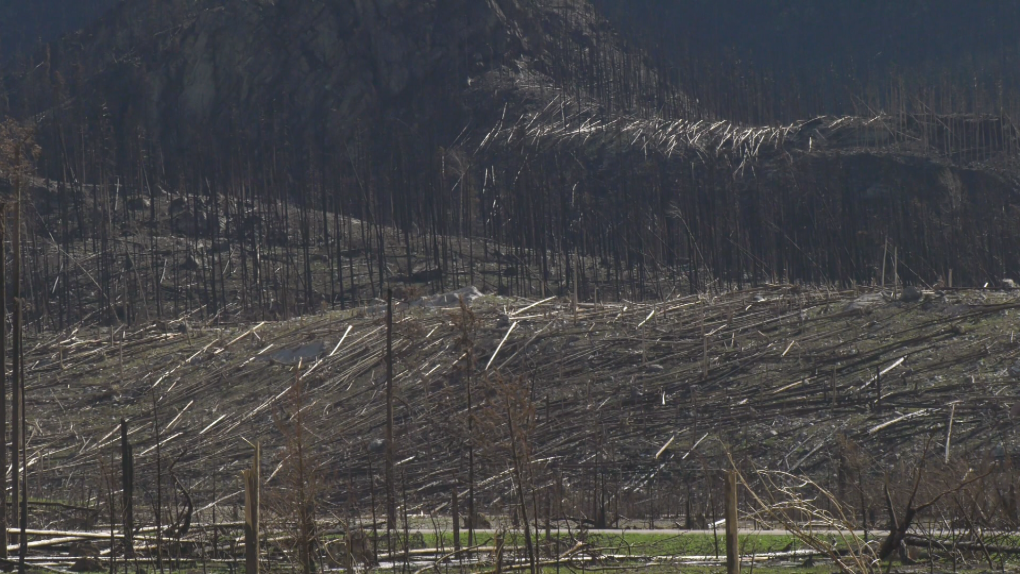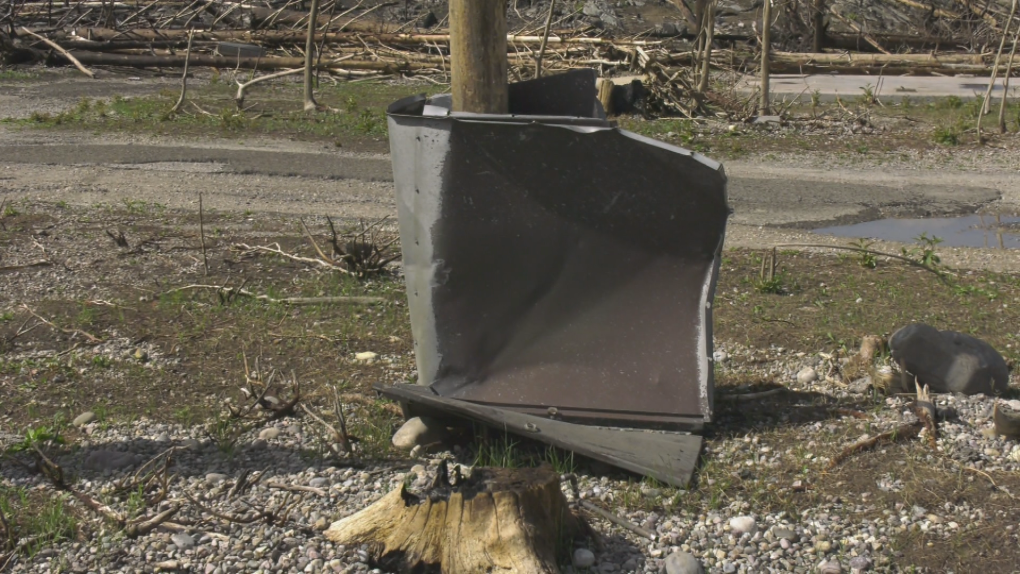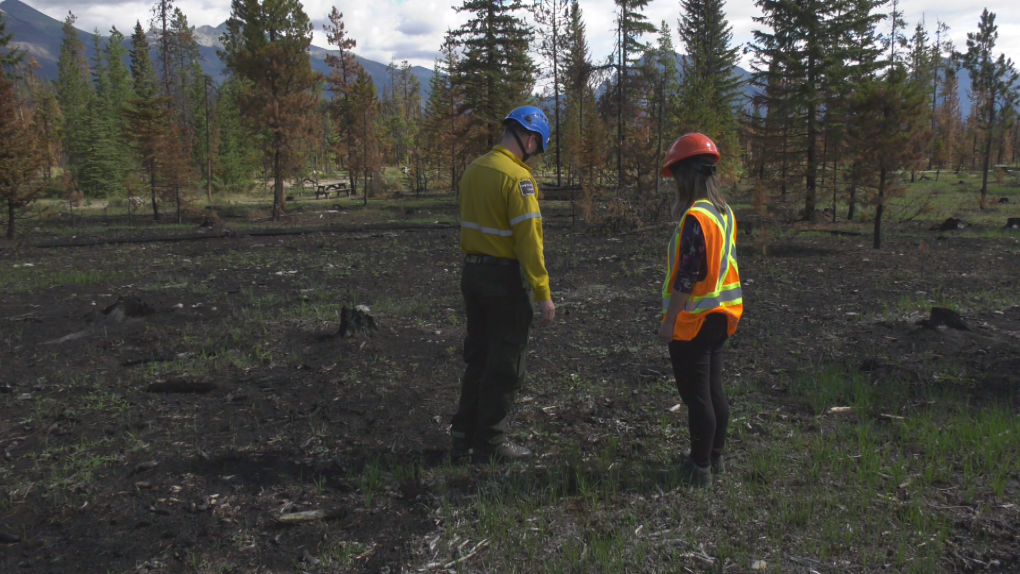Firestorm caused winds up to 180 km/h at Wabasso Campground, leaving trail of destruction
At the Wabasso Campground in Jasper National Park, life is returning to the charred landscape and officials are getting a better picture of the damage left behind by an unusually intense firestorm that ripped through the popular destination last month.
On Wednesday, CTV News Edmonton toured the campground alongside Parks Canada officials.
Hundreds of trees on the north side of the campground could be seen plastered to the ground, downed not by fire, but by hurricane-force winds that tore up asphalt and left tangled metal wrapped around the trees left standing.
"You can see that by all the alignment of the trees, where the trees have been knocked over by the force of that convective suction in the fire column," said Landon Shepherd, a deputy incident commander with Parks Canada.
 Trees can be seen burnt and blown over by intense wind during a firestorm at the Wabasso Campground in July. CTV News Edmonton and Parks Canada toured the site on Aug. 28, 2024. (Sean McClune/CTV News Edmonton)A fire column is an updraft created during a firestorm, when the rising heat from a wildfire creates its own wind system.
Trees can be seen burnt and blown over by intense wind during a firestorm at the Wabasso Campground in July. CTV News Edmonton and Parks Canada toured the site on Aug. 28, 2024. (Sean McClune/CTV News Edmonton)A fire column is an updraft created during a firestorm, when the rising heat from a wildfire creates its own wind system.
According to the National Oceanic and Atmospheric Administration, the rapidly rising heat pulls air from outside of the fire to fill the vacuum left behind.
That creates a powerful updraft, and in the case of very large fires, the rising smoke can condense into a firestorm cloud – or pyrocumulonimbus – which can produce lightning and rain.
 Metal sheeting can be seen wrapped around a tree trunk at the Wabasso Campground, after a firestorm in July. CTV News Edmonton and Parks Canada toured the site on Aug. 28, 2024. (Sean McClune/CTV News Edmonton) Shepherd said on July 24, conditions were just right for things to go wrong.
Metal sheeting can be seen wrapped around a tree trunk at the Wabasso Campground, after a firestorm in July. CTV News Edmonton and Parks Canada toured the site on Aug. 28, 2024. (Sean McClune/CTV News Edmonton) Shepherd said on July 24, conditions were just right for things to go wrong.
"There was a very receptive layer of air just above our taller mountain tops that was able to pull that smoke and all of the ash in the upper atmosphere out of the area, and it just kept drawing more and more fire, almost like a furnace," Shepherd said.
In Wabasso, the winds created by the firestorm were calculated to have reached between 150 and 180 km/h – strong enough to lift a 6,700-pound shipping container and toss it 100 metres into the Athabasca River.
According to the National Oceanic and Atmospheric Administration, 180 km/h wind speeds are equivalent to an F1 tornado or a Category 3 hurricane.
 Parks Canada staff prepare a shipping container for removal from the Athabasca River. According to Parks Canada, the 6,700-pound container was tossed from the Wabasso Campground 100 metres away during a firestorm in July. (Parks Canada)During the tour, several metal fire pit rings could be seen ripped up and strewn across the campground and the riverbank. Shepherd said each one weighs around 75 pounds and is far from aero-dynamic.
Parks Canada staff prepare a shipping container for removal from the Athabasca River. According to Parks Canada, the 6,700-pound container was tossed from the Wabasso Campground 100 metres away during a firestorm in July. (Parks Canada)During the tour, several metal fire pit rings could be seen ripped up and strewn across the campground and the riverbank. Shepherd said each one weighs around 75 pounds and is far from aero-dynamic.
"There's nothing for the wind to grab onto, it's anchored to the ground," he said. "That got lifted up and lobbed across the Athabasca River."
On the other side of the riverbank, Shepherd pointed out a fire pit ring that had been flattened into an oval, suggesting it was dropped from significant height.
"The forces on this side were unbelievable," he added.
 A Parks Canada officials points out a metal fire pit ring that was ripped out the ground during a firestorm at the Wabasso Campground in July. CTV News Edmonton and Parks Canada toured the site on Aug. 28, 2024. (Sean McClune/CTV News Edmonton)
A Parks Canada officials points out a metal fire pit ring that was ripped out the ground during a firestorm at the Wabasso Campground in July. CTV News Edmonton and Parks Canada toured the site on Aug. 28, 2024. (Sean McClune/CTV News Edmonton)
'Severe and intense'
In addition to tearing trees out by the root, the wind wrapped metal roofing around trunks, tore copper pipes out of washrooms and shot a log through a metal grizzly-bear-proof dumpster.
"Even whole trees with 1,000-pound root balls were being carried about by the convective force of this fire," Shepherd said.
 A tree can be seen pulled out by the roots after a firestorm at the Wabasso Campground in July. CTV News Edmonton and Parks Canada toured the site on Aug. 28, 2024. (Sean McClune/CTV News Edmonton)During a wildfire, it's normal to see pine needles and other small debris carried up and away by rising hot air, however that debris is often extinguished by the time it reaches the ground.
A tree can be seen pulled out by the roots after a firestorm at the Wabasso Campground in July. CTV News Edmonton and Parks Canada toured the site on Aug. 28, 2024. (Sean McClune/CTV News Edmonton)During a wildfire, it's normal to see pine needles and other small debris carried up and away by rising hot air, however that debris is often extinguished by the time it reaches the ground.
Shepherd said the fire in Wabasso was intense enough to carry large embers that could be seen starting fires hundreds of metres from the perimeter.
"The bigger the item that convection column can lift, the more likely it is to stay ignited," he said. "Certainly, there were some large objects that dropped towards the community."
According to Shepherd, the amount of available fuel in the area is not to blame for the intensity of the fire.
 Parks Canada said the south side of the Wabasso Campground saw milder, more moderate fire damage, despite having similar landscape and fuel sources. CTV News Edmonton and Parks Canada toured the site on Aug. 28, 2024. (Sean McClune/CTV News Edmonton)He said the campground had been cleared of trees damaged by mountain pine beetles, and there were fire breaks in the area.
Parks Canada said the south side of the Wabasso Campground saw milder, more moderate fire damage, despite having similar landscape and fuel sources. CTV News Edmonton and Parks Canada toured the site on Aug. 28, 2024. (Sean McClune/CTV News Edmonton)He said the campground had been cleared of trees damaged by mountain pine beetles, and there were fire breaks in the area.
"We were using all the tools and tactics that you can use, starting over 20 years ago, to try and interrupt a fire like this," Shepherd said. "This is a little more severe and intense than most people have ever experienced, even in my business of fire management."
Once the fire was going, he said there was also little that could be done to stop it, given the sheer intensity.
"Even if you could divert the Athabasca River on the head of this fire, it would have evaporated before it could get down and cool that flame front," he said.
With files from CTV News Edmonton's Nicole Weisberg
Correction
A previous version of this story incorrectly stated that wind speeds of 180 km/h were equivalent to an F3 tornado. They are, in fact, equivalent to an F1 on the Fujita Scale.
CTVNews.ca Top Stories

W5 Investigates Provinces look to Saskatchewan on how to collect millions more for victims of crime
A W5 investigation showed how convicted criminals ordered to pay restitution struggled to do so, and how just $7 million of more than $250 million had been claimed. While many provinces struggle to keep track, Saskatchewan is leading the way in making sure victims get their money.
'Tragic and sudden loss': Toronto police ID officer who died after suspected medical episode while on duty
A police officer who died after having a suspected medical episode on duty was executing a search warrant in connection with an ongoing robbery investigation in North York, Toronto police confirmed Thursday.
Who received the longest jail terms in the Gisele Pelicot rape trial?
A French court found all 51 defendants guilty on Thursday in a mass rape case including Dominique Pelicot, who repeatedly drugged his then wife, Gisele, and allowed dozens of strangers into the family home to rape her.
PM Justin Trudeau planning sizable Friday cabinet shuffle, sources say
Prime Minister Justin Trudeau is planning a sizable cabinet shuffle on Friday, sources confirm to CTV News. The long-awaited reconfiguration of Trudeau's front bench comes amid turmoil for the Liberal government after the shocking resignation of Chrystia Freeland.
Child struck by vehicle south of London has died
According to an online fundraiser organized by a family friend, the boy who was hit by a driver south of London earlier this week has died.
Manitoba man wins $40M Lotto Max jackpot
A Manitoba man has won one of the top five largest lottery jackpots in Manitoba history.
64 cases of 'norovirus-like' illness linked to raw oysters in B.C., officials say
Dozens of people have become ill after eating raw oysters in B.C. since Nov. 1, public health officials warned Thursday.
Conan O'Brien pays tribute to his parents who died within days of each other
Conan O’Brien is remembering his recently deceased parents. In an interview with the Boston Globe, the former late night television host talked about his mother, Ruth Reardon O’Brien, who died last Thursday, and Dr. Thomas F. O’Brien, who preceded his wife in death three days earlier.
N.B. Liberal government revises Policy 713, parental consent no longer required for students' preferred names
The New Brunswick Liberals are reversing course on the previous government’s decision to change Policy 713.

































